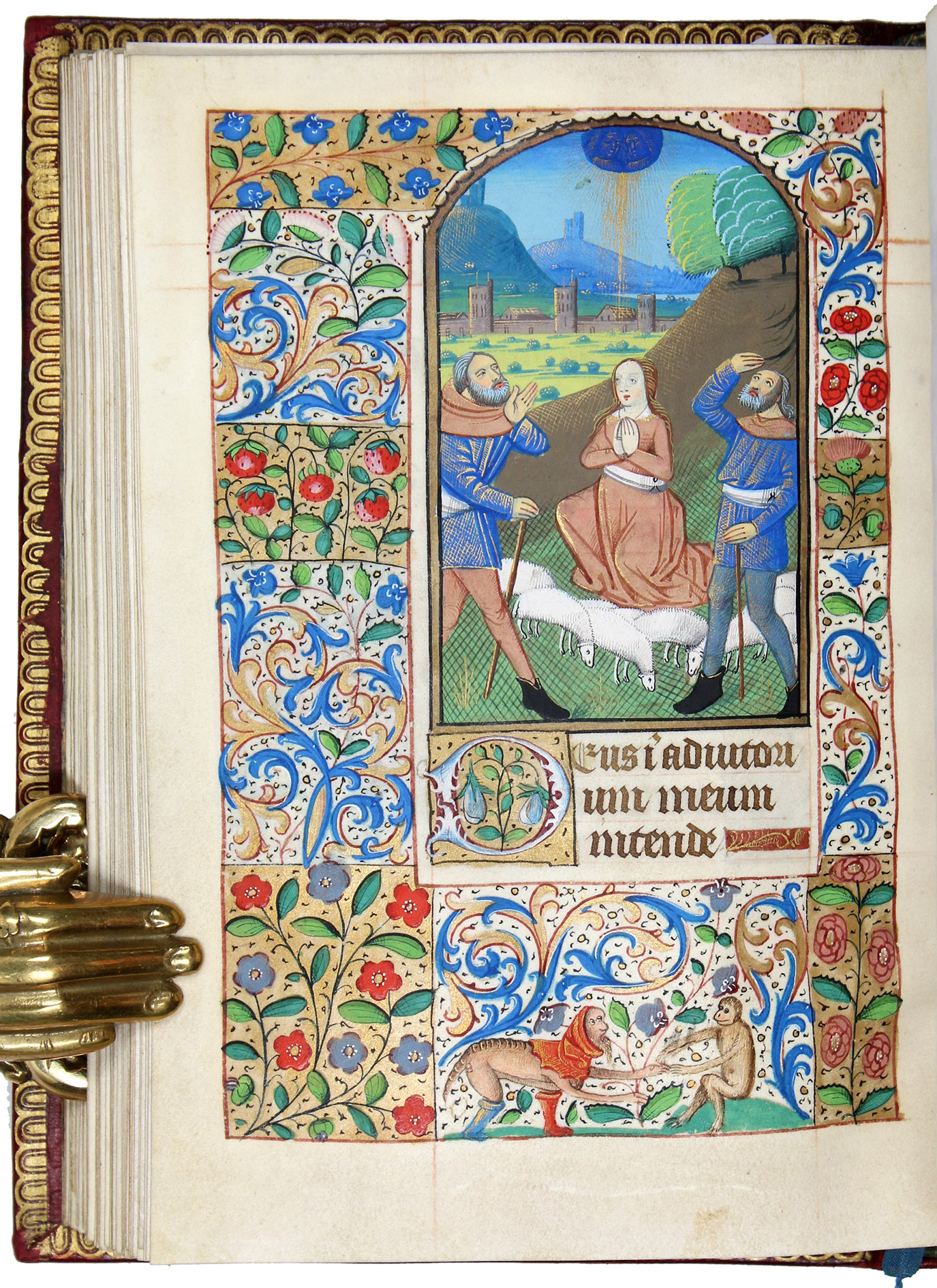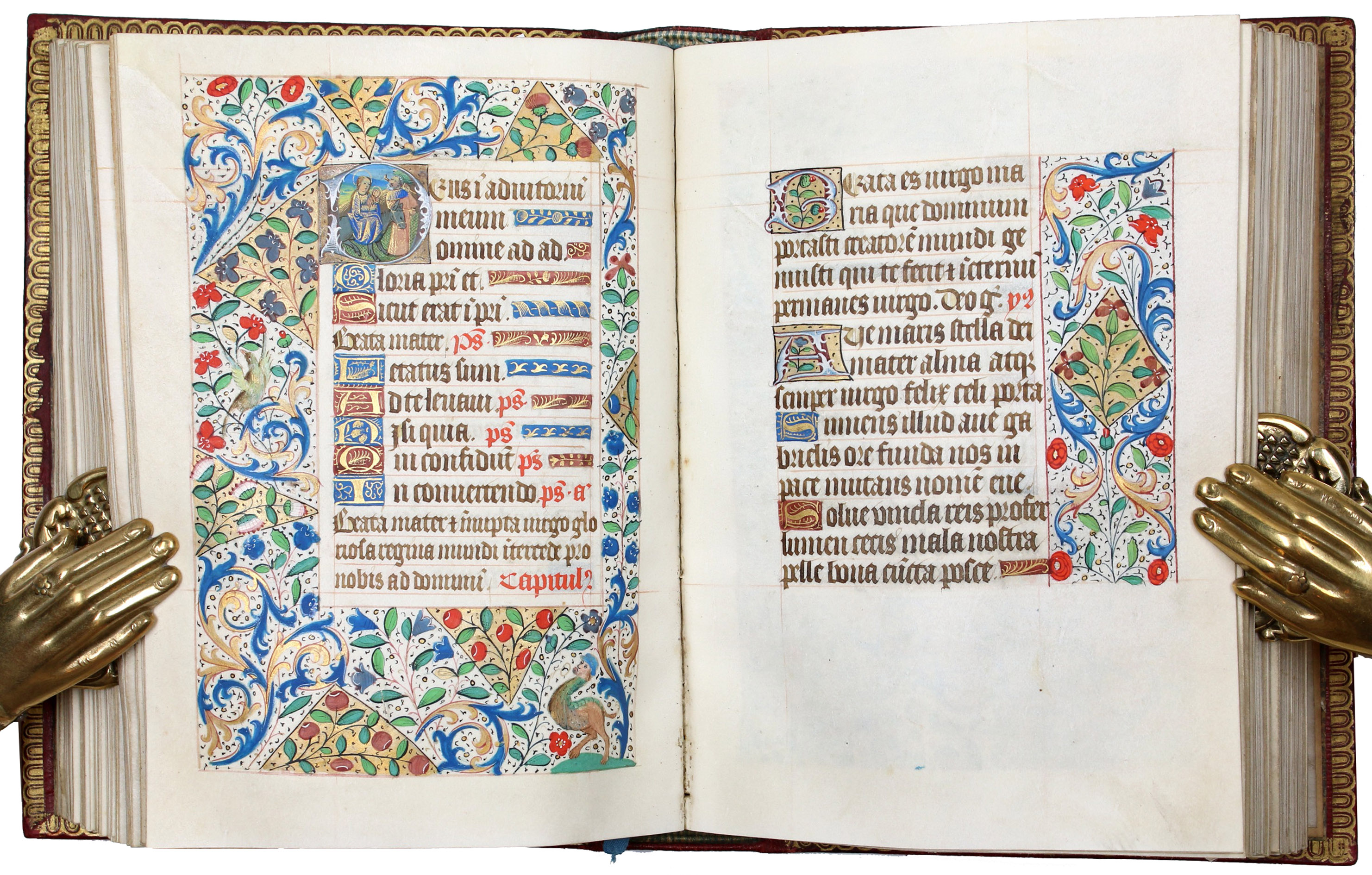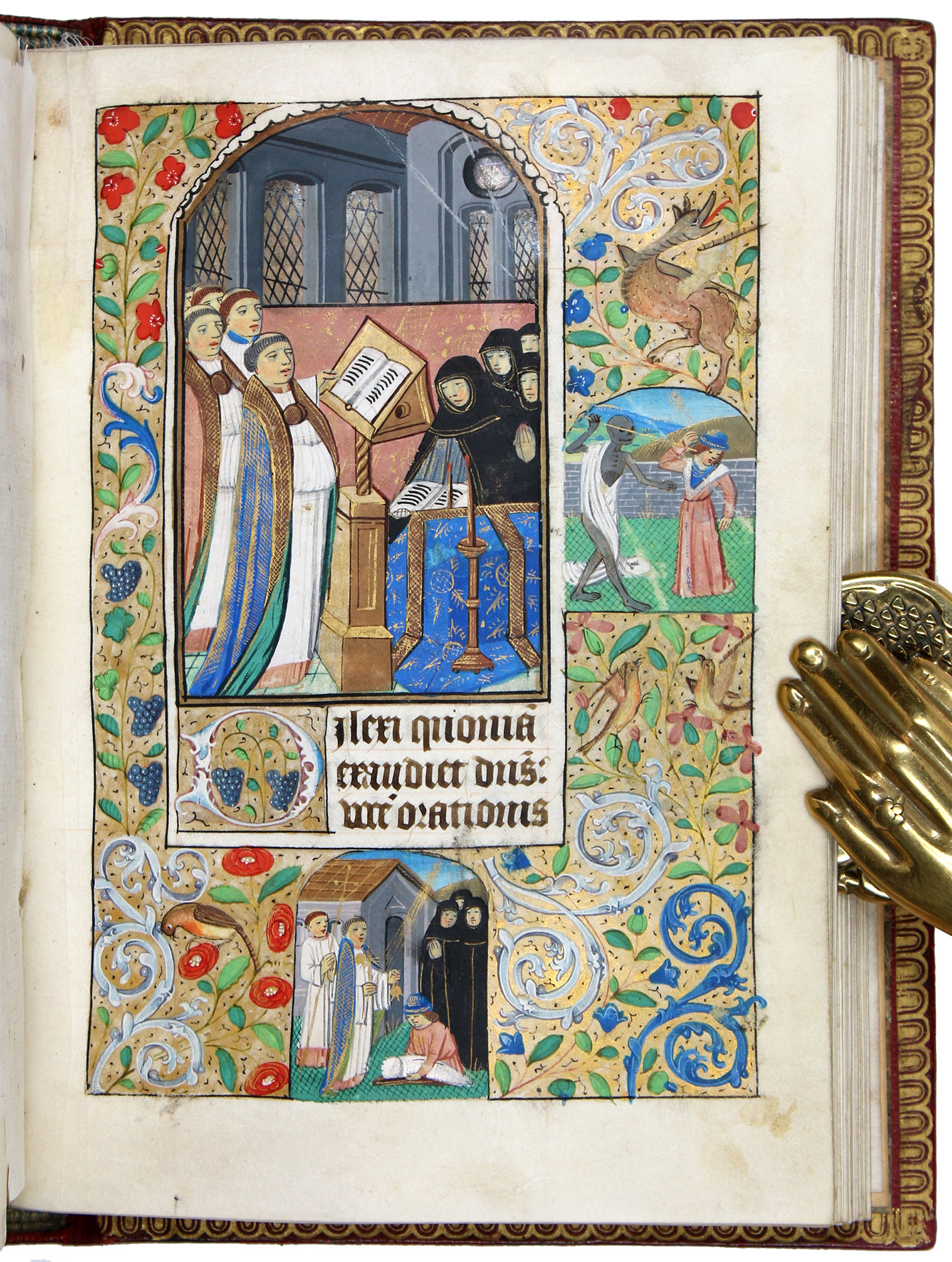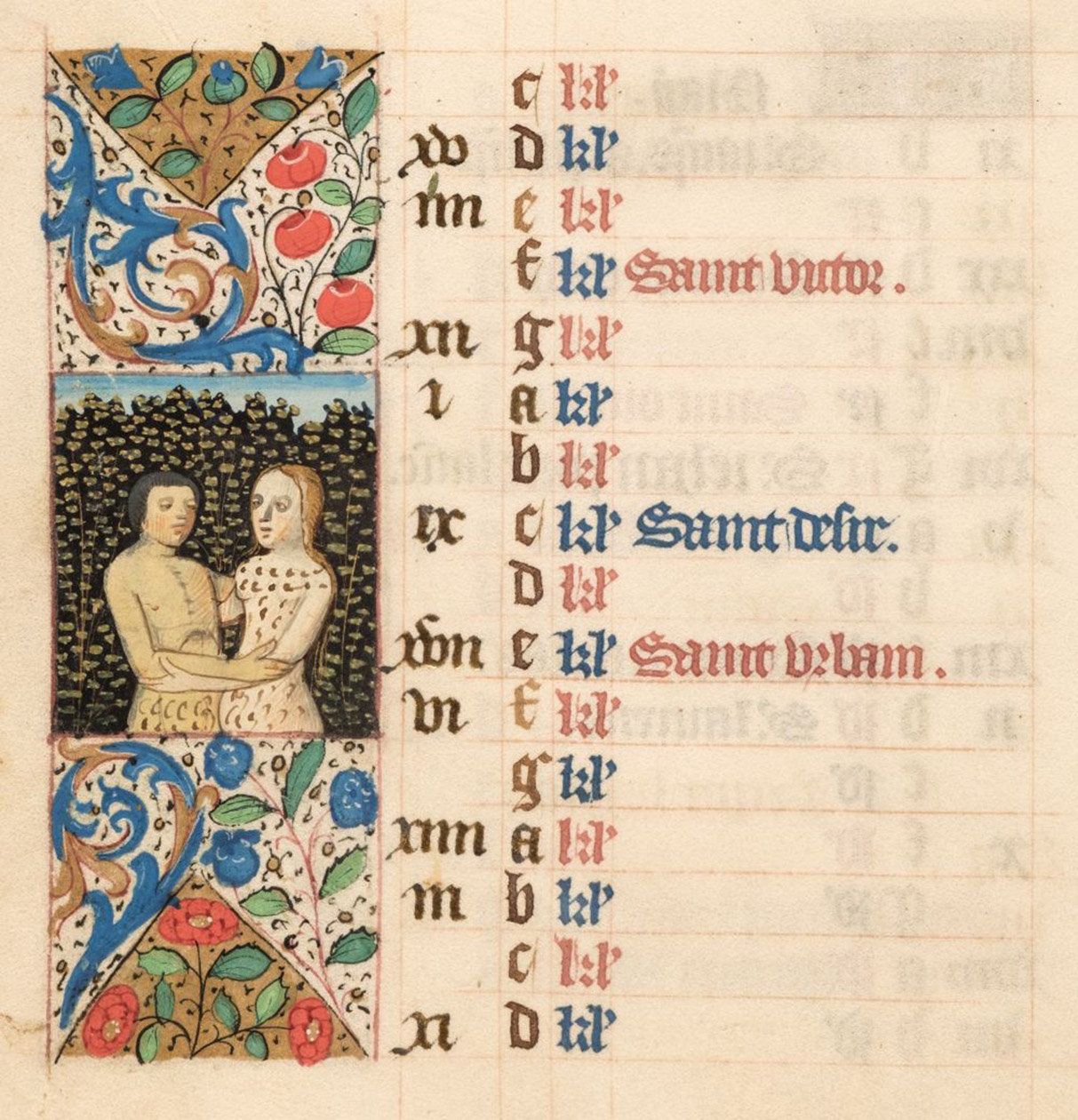[BOOK OF HOURS].
[Book of Hours - use of Rouen].
Rouen, Normandy, France, ca. 1480. Small 4to (14.3 x 19.3 cm). Latin and French illuminated manuscript on vellum. Ruled in red ink for 14 lines per page (16 in the calendar). Gothic textura, major feasts in calendar in burnished gold, others alternately red or blue. Text pages illuminated with panel borders of flowers and plants on gold, and blue and gold stylised acanthus on a plain ground. Calendar has 24 small square miniatures set into panel borders; major text divisions marked by 12 large miniatures; 2 historiated initials; hundreds of smaller initials and line-fillers throughout. 18th-century French gold-tooled red calf over pasteboards, with the title lettered in gold on the spine, gilt edges, marbled endpapers. [160] ll.
€ 165,000
A Rouen Book of Hours of outstanding quality and in slightly larger than usual format, commissioned by a female patron who is portrayed in the last miniature awaiting the arrival of the Messiah.
The style of illumination is typical of that practised in Rouen during the late 15th century. Characteristic features include the profuse use of gold highlights on draperies and hillsides, often cross-hatched; cross-hatching of grassy areas in landscapes; a palette predominantly based on pink, blue, brown and green, and the use of grey for the modelling of facial features, men having rather swarthy flesh, and women very pale skin; the rather peremptory manner of painting hands; the grey-blue acanthus on flat gold backgrounds for borders. Also the liturgical use points to Rouen as the place of production: the sparse calendar includes St Romanus (23 October) in gold, as well as St Evodius (8 October) and Mellonus (22 October), all three were bishops of Rouen; Romanus and Mellonus also appear in the Litany. Prayers are written for the use of a female supplicant, and a conventional portrait of the original owner appears in the final miniature.
Contents: calendar, in French (f. 1r); Gospel extracts (f. 13r); prayers "Obsecro te" and "O intemerata", using feminine forms (ff. 20v); Hours of the Virgin (f. 31r), Lauds followed by suffrages to the Holy Spirit, Nicholas, and Katherine; Seven Penitential Psalms (f. 83r) followed by (f. 98r) a Litany of saints (Clement, Fabian, and Sebastian, at the bottom of f. 100r, are mistakenly repeated at the top of the verso); Hours of the Cross (f. 105) and of the Spirit (f. 109r); Office of the Dead (f. 113r); "Les quinze joies nostre dame" (f. 151r) and "Les sept requestes" of the Lord (f. 157r), both in French.
Illumination: the calendar (ff. 1r-12v) has occupations of the months on rectos, and zodiac signs on versos. January: feasting; Aquarius. February: warming at a hearth; Pisces. March: pollarding; Aries. April: half-length man in a garden; Taurus. May: man and woman on horseback, hawking; Gemini: a naked man and woman embracing. June: scything; Cancer. July: reaping; Leo. August: threshing; Virgo. September: treading grapes; Libra. October: sowing seed; Scorpio. November: knocking acorns from trees to feed pigs; Sagittarius. December: killing a pig; Capricorn.
The major texts are each introduced by a large miniature, including the individual Hours of the Virgin, except Vespers and Compline which have historiated initials:
1. (f. 13r) The Four Evangelists, in a four-part miniature characteristic of Rouen.
2. (f. 31r) The Annunciation, surrounded by a border composed of nine smaller compartments: three with angels, the other six with scenes from the life of the Virgin: Gabriel appearing to Joachim; Meeting at the Golden Gate; Nativity of the Virgin; Presentation of the Virgin; Virgin at the Loom; and Marriage of the Virgin to Joseph.
3. (f. 44v) The Visitation.
4. (f. 59r) The Nativity.
5. (f. 65v) The Annunciation to the Shepherds.
6. (f. 69v) The Adoration of the Magi.
7. (f. 73r) The Presentation in the Temple; the infant has his arms outspread, visually prefiguring his Crucifixion.
8. (f. 76v) The Flight into Egypt (historiated initial).
9. (f. 78r) The Coronation of the Virgin (historiated initial).
10. (f. 83r) King David in Penitence; the border with smaller miniatures depicting David and Goliath, and David Spying on Bathsheba.
11. (f. 105r) The Crucifixion; the border with smaller miniatures depicting the Flagellation, and Christ carrying the Cross.
12. (f. 109r) Pentecost.
13. (f. 113r) A Funeral Service; the border with smaller miniatures depicting Death in the form of a cadaver killing a man, and a priest officiating at a burial.
14. (f. 151r) The Virgin and Child enthroned, adored by an angel and a female patron.
Provenance: 1) Purchased in 1949 from William H. Robinson, Pall Mall booksellers, per pencil note on verso of front flyleaf: "From Robinsons, 25/8/49", by 2) William Alfred Westropp Foyle (1885-1963), British bookseller, with his burgundy morocco gilt bookplate to front pastedown. 3) By descent to his grandson William Richard Mervyn Christopher Foyle (1943-2022), aviator and bookseller.
Front board somewhat stained. A few minor blemishes (e.g. slight pigment loss in the lower right corner of the miniature on f. 31r, and slight water-staining in the lower left corner), but generally in fine, clean condition throughout, with ample margins. An erased 17th-century(?) inscription in the lower margin of fol. 2r reads "Mon dieu qui voicy [?] est bon"; the same hand may have been responsible for lightly disguising the nudity that occurs in some marginal scenes, including Aquarius (leaf 1v), Gemini (leaf 5v) and Bathsheba (leaf 83r).
Related Subjects:




















